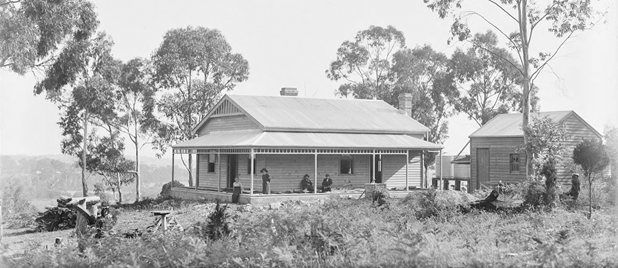News - September 2022
Tuesday 20 Sep - 7:30pm General Meeting
VENUE: Old Sunday School, St Johns Park Precinct
GUEST SPEAKER: Prof Pam Sharpe
TOPIC: The secret journal of Pte Robert McNally's - soldier in Van Diemen's Land in the 1820s
Just occasionally an historian strikes gold. For Pam Sharpe this was discovering the diary/memoir of Private Robert McNally in the National Library of Ireland. Private McNally, 40th Regiment of Foot, served in Van Diemens Land during the mid-1820s. Prof. Sharpe will discuss the surprise discovery of this damaged and rare anonymous journal providing an insight into Van Diemen's Land in the years leading up to the Black War.
Pam Sharpe was the first female Professor in History at the University of Tasmania and the first woman nominated to the Australian Academy of the Humanities from Tasmania. A graduate of Edinburgh and Cambridge Universities, she is an expert in British social and economic history who has expanded her interests to Van Diemen's Land
NOTE: Members and visitors are currently requested to wear masks for the safety of all when attending meetings of the TFHS Hobart Branch. Spare masks are available if you do not have one to hand.
More for Your Diary
Thu 15 Sep - 10.00am Branch Committee Meeting
VENUE : Supper Room, St Marks Church Hall
Thu 15 Sep - 1.30pm DNA Group Meeting
VENUE : St Marks Church Hall
Thu 22 Sep - 2pm Library Committee
VENUE : Library
Tue 18 Oct - 7:30pm General Meeting
VENUE : Old Sunday School, St Johns Park Precinct
SPEAKER : Rex Cox
TOPIC : Convicts to Containers: looking at how Hobart's port has developed within and beyond Sullivans Cove over two centuries
Cornelian Bay Cemetery: 150 Years Old
This year is the sesquicentenary of the opening in July 1872 and first burial in October 1872 of the Cornelian Bay cemetery.
It is the second oldest cemetery of any capital city in Australia, with Rookwood, Sydney being five years older.
Long-time member Maree Ring researched and wrote an extensive history of the cemetery, which was published in June 2002 in Tasmanian Ancestry, Volume 23, number 1. A copy of that volume may be downloaded from our website here.
Library Accessions August 2022

The following items were accessioned during the month of August 2022
Books
* Denotes complimentary or donated item
* Arts Tasmania; NO MORE BREAD & MILK - Stories from St Johns Park [994.6 NOM]
* Binks, C. J.; EXPLORERS OF WESTERN TASMANIA [Q919.66 BIN]
* Blainey, Geoffrey; THE PEAKS OF LYELL (Third Edition) [622.099466 BLA]
* Bowden, Tim; THE WAY MY FATHER TELLS IT - The story of an Australian life [994.06 BOW]
* Broxam, Graeme; A STEAMSHIP FOR HOBART - S.S. Reemere 1909 [387.509946 BRO]
* Clayton, Mark; PORT ARTHUR - A PENAL HISTORY [994.64 CLA]
* Cooley, Thomas C. T.; A HISTORY OF TRAINS AND TRAMS IN TASMANIA [385.09946 COO]
* Curtis, Brian; THE SYDNEY - HOBART MY 21 YEARS [797.14 CUR]
Dunn, Cathy; SETTLERS AND LANDHOLDERS NORFOLK ISLAND 1793 [Q929.3944 DUN]
* Fenton, James; BUSHLIFE IN TASMANIA [994.65 FEN]
* Franklin Direct; MEMORIES OF TASMANIA - SNAPSHOTS OF OLD HOBART [994.61 MEM]
* Hipkins, Max; CORNWALL TO THE AUSTRALIAN COLONIES - Pearce Family History [Q929.2 PEA]
* Julen, Hans; THE PENAL SETTLEMENT OF MACQUARIE HARBOUR 1822-1833 - An outline of its history [365.9946 JUL]
* Lord, Richard; THE ISLE OF THE DEAD, Port Arthur [929.5099946 LOR]
* O'May, Harry; HOBART RIVER CRAFT and SEALERS OF BASS STRAIT [387.509946 OMA]
* Ross, Michael and Alex Graeme-Evans; A SHORT HISTORY GUIDE TO PORT ARTHUR 1830-77 [994.64 ROS]
* Southerwood, W.T.; LAUNCESTON PARISH - A Sesqui-Centenary History (1838-1988) [282.9465 SOU]
* Toghill, Jeff; THE JAMES CRAIG - Her history, recovery and restoration [387.2 TOG]
Beyond 2022 - The Reconstructed Irish Archives
https://www.nationalarchives.ie/news/launch-of-the-virtual-record-treasury-of-ireland/
The Virtual Record Treasury of Ireland is the outcome of a five-year State-funded programme of research entitled 'Beyond 2022'. Led by Trinity College Dublin, 'Beyond 2022' has combined historical investigation, archival conservation, and technical innovation to re-imagine and recreate, through digital technologies, the archive of the Public Record Office of Ireland that was lost on 30th June 1922 during the destruction of Dublin's Four Courts at the outset of the Civil War.
The Virtual Record Treasury was launched in time for 30th June 2022. You can do a 3-D virtual tour at and see its virtual contents at . You can even search for old Irish family history records.
The Story of York Castle Prison
York Castle has been a site of justice and incarceration for almost 1,000 years.
William the Conqueror built the first castle here in 1068 as a base to control the North of England - and we know from written references that it had a prison.
The Castle is still a seat of justice today; the 18th century Courthouse is now York Crown Court. It still has holding cells and people accused of serious crimes are still tried there, as they have been for almost 1,000 years.
Life in the Prison
Life in Georgian England was far harsher than it is today - so you can imagine that life behind bars was even worse.
The Prison was divided into different floors, with the debtors above and the felons in the worst conditions below. They would sleep twelve or fifteen to a cell, "which causes very faint and nauseous smells and violent sicknesses". The poorest of them would live on bread and water, sleep on bare boards, and wear nothing but rags in the unheated cells.
And the prison was a profit-making business. The staff - the Turnkey and his men, even the Keeper (the equivalent of today's Governor) - were there to make money.
Prisoners would have to pay for their beds and food. And if the Turnkey forced prisoners to buy their food from him, with a handsome mark-up, he made even more profit.
The Prison was a place to hold men and women awaiting their trial or punishment. If you survived the terrible conditions there were three ways out; be found 'not guilty' and released, be transported overseas as convict labour… or the gallows.
The Petitions
Petitions were written pleas for help that prisoners sent to the County Magistrates. Sometimes 80 or even 100 prisoners put their names to a list of complaints.
The magistrates paid attention to the petitions and often acted on the complaints in them. Prisoners did not have much power, but this system of petitioning at least helped them reduce the risk of dying from starvation, cold, disease or torture.
Original petitions survive from the early years of the 18th century and give a glimpse of life in the prison at York Castle.
More information can be found by going to York Castle Prison.
Libraries Tasmania
If Walls Could Talk: researching the stories and histories of Tasmanian buildings

Image citation: Tasmanian Archives: Photograph - House at Dodges Ferry
(1896), NS1553/1/469
Do you know when your house was built, or who lived there before? Or, do you want to find out more about where an ancestor lived in Tasmania?
Visit in person at the State Library and Tasmanian Archives Reading Room from early August.
Showing until March 2023, our building history display at the State Library and Tasmanian Archives Reading Room illustrates different pathways to finding out more about the history of your own home, or a place from the past that may have significance to your family heritage.
These historic photographs and films, newspapers, census records, maps, house plans, deeds and land grants - all reveal a rich insight into the structural history and architecture of a particular building, as well as the varied lives of inhabitants.
Learn how to find out how a property may have changed over time, research past owners and occupiers, and discover the origins and significance of places and communities in the surrounding regions.
Curious about what you might find in the Tasmanian Archives ? Home to more than 1.2 million archive and heritage items, you can easily explore the archives from your own device.
Family History Down Under 2022
A world-class family history conference with in-person and virtual options
Unlock the Past is delighted to announce that Family History Down Under 2022 (FHDU 2022) is now just two months away. The 4-day in-person conference will be held 8-11 November 2022 at Castle Hill, near Sydney. Two virtual options bring FHDU 2022 within reach of anyone, wherever they are, who cannot join us at Castle Hill.
Overview
There will be four main theme or tracks
- DNA
- Researching Abroad
- Australia & New Zealand
- Methodology & General.
Choose from 70+ presentations from 35 presenters from seven countries, plus 11 workshops and two conference dinners. The exhibition, which is both in-person and virtual, offers big savings from sponsors and exhibitors. And around AU$12,000 in prizes will be up for grabs. The FHDU 2022 Community (a private Facebook chat group) will be available for interaction between attendees, speakers and sponsors. All presentations, except workshops and conference dinner talks will be available for all attendees (in-person and virtual) to view until 28 February 2023.
Venue
Castle Hill RSL Club is a fantastic venue. It is close to Sydney, Australia's largest city, with access via Sydney Metro Northwest rail, onsite parking and plenty of accommodation nearby. It has multiple large capacity conference rooms and multiple lounges, bars and dining choices for these who would like to gather after each day's program.
I hope you will join us at Castle Hill or virtually for one last farewell event in November 2022. Find out more at our website or email us.
